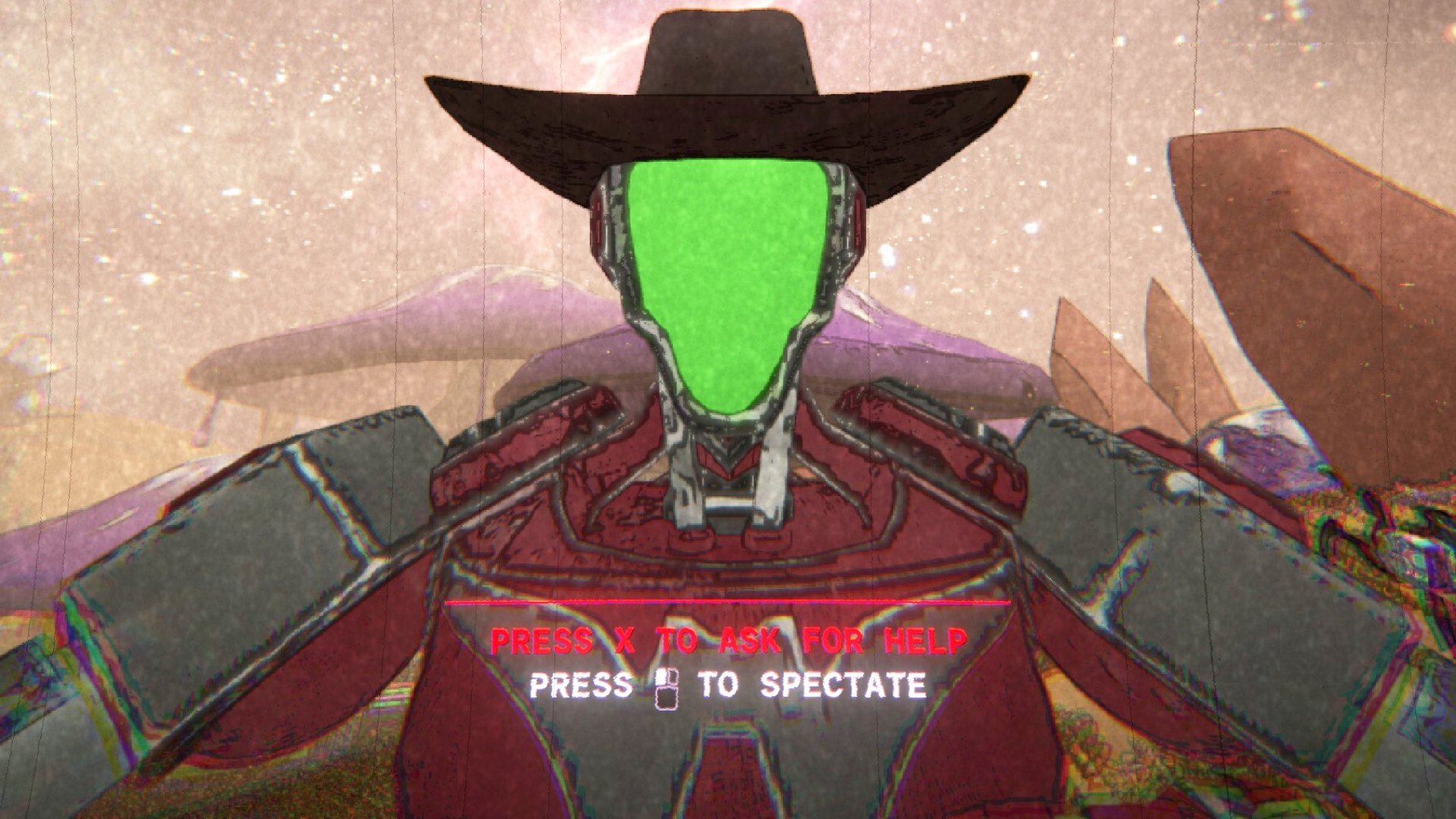The best Hearthstone Duels decks and strategies for each class
Discover the best Hearthstone Duels deck for each class, and how to use them.
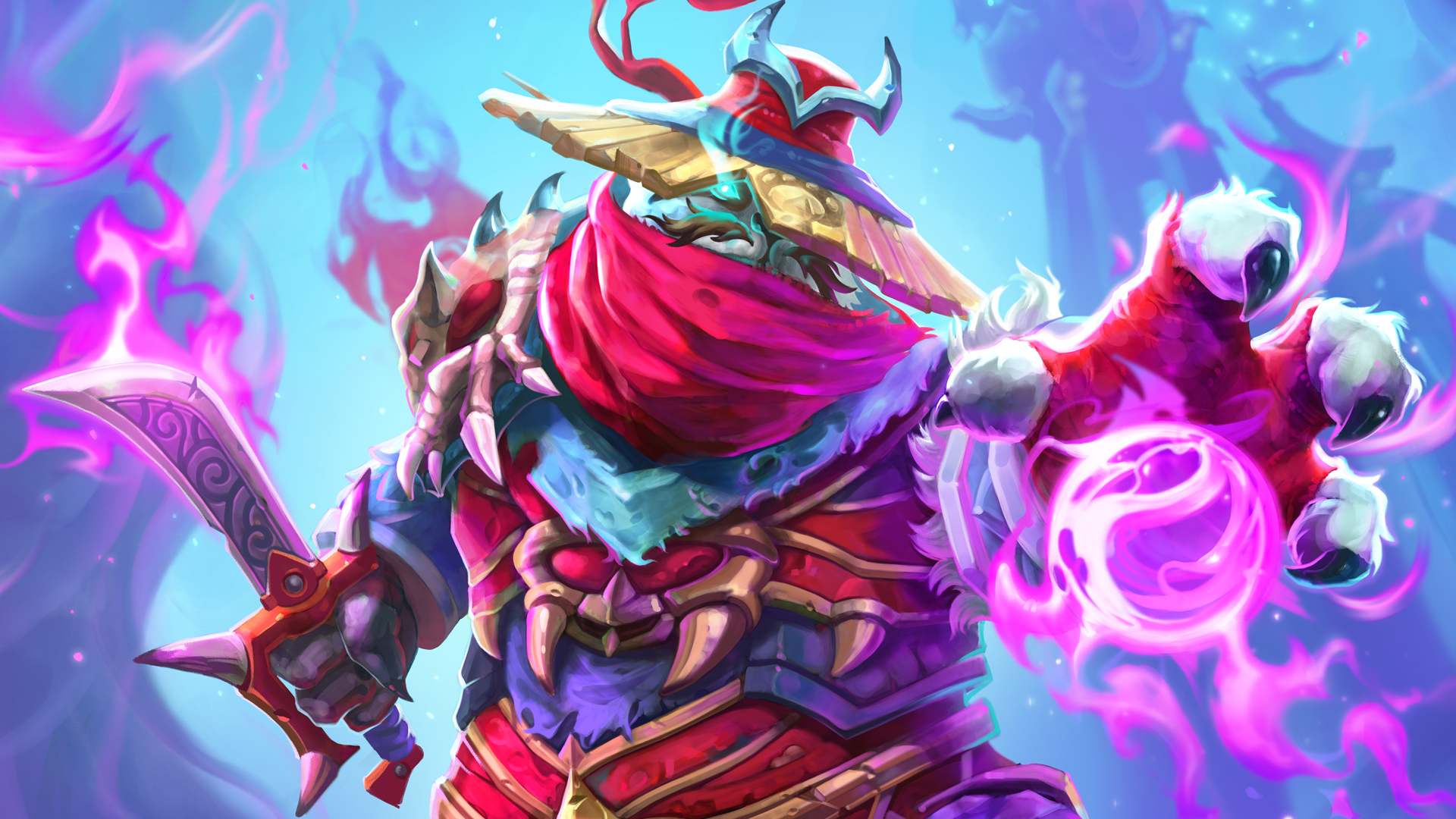
Looking for the best Hearthstone Duels decks for each class? Duels is Hearthstone’s new game mode, finally bringing the dream of PvP Dungeon Runs to life. Starting with a small constructed deck of fifteen singleton cards and a signature treasure, you fight through an Arena-like gauntlet against other players as you build ridiculously powerful decks. It may seem daunting at first, but with this list of class strategies and starting decks, you’ll be a top tier duelist in no time.
The best Hearthstone Duels decks and strategies for each class
Rogue
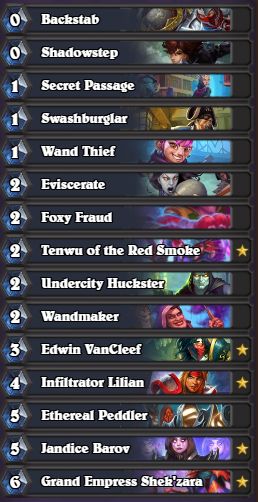
After starting out as one of the worst classes in the format, Rogues now have two decent archetypes to choose from. You can stick with Roguish Maneuvers and Deadly Weapons 101, or you can go for an endless array of Combo triggers and cheap board presence with Connections and Nerubian Peddler. The latter has much more staying power and has a better chance for a deep run, but the former might be easier to start with if you’re new to the format, especially because it is cheaper to build.
The one-mana dagger (which becomes a 2/2 with Combo) is a brutally consistent and efficient tool, reminiscent of the ‘Even’ decks from the past. Now the class always has access to a dagger with minimal mana investment, allowing for more consistent strategies revolving around weapon buffs.
Focus on weapons and synergistic cards in your future bucket picks. The fact that Self-Sharpening Sword is outright banned in the initial deckbuilding phase should be a strong hint that you should pick it at every opportunity later on.
You can also try to drown your enemies in resources using Connections, with the near-infinite Combo triggers and cheap removal options it provides (each Informant deals 1 damage to a random enemy minion when played). I’ve featured such a deck below, one which reached 12 wins when piloted by Ramses_hs:
Deck code:
AAEBAaIHD7QBsgLtAogH8rACkrYClLYCqssDpNED2dED/tEDq9ID390D6t0Dw+EDAAA=
Cost: 8700
Keep up to date with the most important stories and the best deals, as picked by the PC Gamer team.
Hero Power: Roguish Manoeuvers
Signature Treasure: Deadly Weapons 101
Best passive treasure: For a Roguish Manouvers deck, the best pool 1 option is Pillage the Fallen. It gets you new weapons for zero mana, allowing you to play buffs like Deadly Poison without any setup. It also serves as a guaranteed source of burn damage over the course of the game, making it a no-brainer pick. Since you can still do Rogue shenanigans, anything with mana cost reduction also benefits you greatly, including Crystal Gem for early combo weapon setups.
The best pool 2 options are Double Time and Emerald Goggles for standard mana-cheating. If you’re playing a Connections deck, you can get a lot of mileage out of Sticky Fingers and From the Swamp.
Shaman
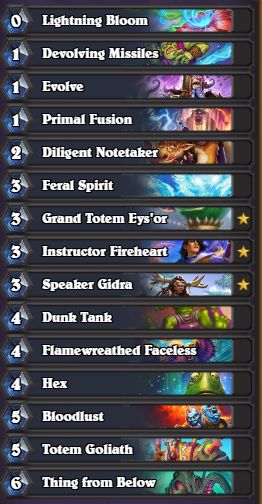
Shamans were the pacesetters in Duels early on. They got brutalized by a nerf, but are now primed for a comeback thanks to their strong Whispers of the Old Gods class cards. Evolve can be an instant knockout punch on a wide board, while Flamewreath Faceless coupled with Lightning Bloom is a nightmarish early play. Primal Fusion and Thing from Below synergize well with Totem-specific strategies. This means you should stick with Fluctuating Totem for synergies. The addition of Grand Totem Eys’or to the summon pool has turned the class viable again, allowing you to build a surprisingly tall board purely out of totems.
Deck code: AAEBAaoID/DUA+DMA/qqAvaqAuHMA+4B3+EDnM4D9c4Dp94D96oC/gWTCabRA/uqAgAA
Cost: 6220
Hero Power: Totemic Power
Signature Treasure: Fluctuating Totem
Best passive treasure: Recycling used to be a sleeper OP pick because it shuts down any burn-based strategies, and is a strong contender once again. Try Cannibalism as a strong aggressive alternative. Unfortunately, Band of Bees is now an ultra-rare treasure so you shouldn’t bank on finding it in pool 2.
Warrior
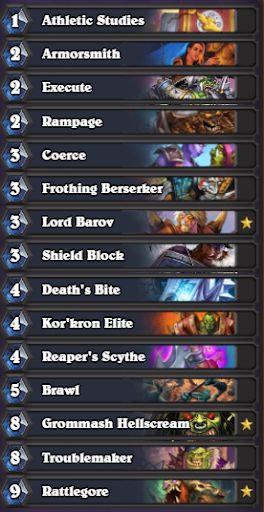
Grommash Hellscream to the face! That’s how most of your Warrior wins will conclude in Duels. Greedy builds with Rattlegore are the current kings of the format. A starting deck chock full of survival tools followed by a two-turn kill setup is what you’ve got here, one greatly aided by the buff to the Warrior hero power (now down to just one mana). The Auto-Armaments signature treasure makes it easier to cycle through your deck to find the combo cards. Just be careful. Brewster the Brutal doesn’t do enough for seven mana in Duels—an overly expensive removal/redraw tool that does nothing Warriors can’t take care of normally. Same goes for the Menagerie shenanigans.
Deck code:
AAEBAQcPHEvSAtQEjgWRBv8H1AiNDuLMA+PMA6fOA4rQA5PQA6vUAwAA
Cost: 5780
Hero Power: No Guts, No Glory
Signature Treasure: Auto-Armaments
Best passive treasure: From the Swamp has incredible synergy with your starting hero power, making it a nightmare for token-based aggressive opponents to contest your board. Unlocked Potential is a sleeper thanks to its synergies with cards as varied as Armorsmith and Grommash Hellscream, but Warrior can utilise most of the common treasures with the right build. Its hero power helps it get more mileage out of Caltrops than any other class, while Pillage the Fallen can meaningfully help speed up the game in your favor. If you’re looking for more time to execute your gameplan, Rocket Backpacks synergizes well with Athletic Studies and Recycling can also serve as a nifty tool to help you get to the point where you can wait no longer.
Demon Hunter
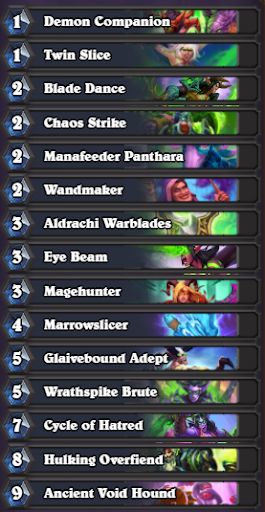
Much like Shamans, Demon Hunters were one of the best classes on the release of Duels and promptly got nerfed to oblivion, though in this case their downfall was partly influenced by what happened to another class. With Rogues becoming so effective at mowing you down in a few turns, they rendered aggressive Demon Hunter strategies redundant (at least until the launch of Madness at the Darkmoon Faire).
Now, your best bet is a hyper-aggressive build that can leverage your Outcast-synergistic Hero Power and starting treasure. If you play it right, Gift of the Legion can deal a Pyroblast’s worth of damage by itself. Keep your curve as low as possible throughout the run and send as much damage upstairs as possible. A build like this can even outpace weapon-based Rogue decks when it comes to burst, and your goal is to make sure that you can disrupt your opponent’s plans long enough with cards like Mana Burn and Consume Magic to deliver the killing blow.
Deck code: AAECAea5Aw/XuwPgvAPUyAP3yAP8yAPyyQPczAPhzgOC0APG0QPP0QP+0QPO0gOK1APZ3gMAAA==
Cost: 1460
Hero Power: Outlander
Signature Treasure: Mo’arg Outcast
Best passive treasure: Pillage the Fallen offers free weapons to fragment enemy faces with and is therefore the best of the bunch. With such a hyperaggressive approach, even Small Pouches or Fireshaper can get you far when picked from pool 1. Double Time is the no-brainer pick from pool two.
Mage
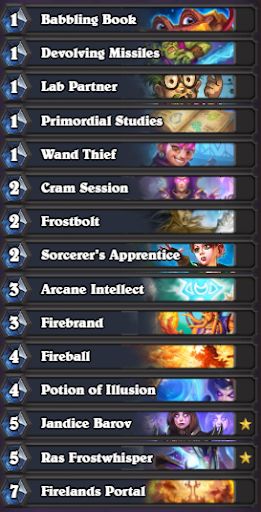
Hitting faces with spells is a time-honored tradition of Mages in Hearthstone, and it’s their go-to approach in Duels as well. Pinging minions down (and generating a free Mana Wyrm in the process) is a strong way to shut down early aggression, until you reach the point where you chuck burn spell after burn spell at your opponent to close out the game.
This explains why Wand of Dueling shouldn’t be underestimated, especially because its potential replacement is such a tricky one. Infinite Arcane’s mana discount only comes into play in long matches, but quickly loses relevance in the ultra-late game. It’s the option to discover your topdeck that is huge. Can you sink five mana into activating the effect? It’s definitely not a build-around treasure and it’s a greedy choice if you’re facing aggressive opponents.
Deck code:
AAEBAf0ED7sCqwTmBJYFgbICo7YC4MwD+MwDhc0Dzc4D0M4DpNED2dED5dED99EDAAA=
Cost: 4440
Hero Power: Wyrm Bolt
Signature Treasure: Wand of Dueling
Best passive treasure: Double Time is incredible, but Robe of the Apprentice and Rhonin’s Scrying Orb (and their upgraded versions) are also straightforward picks. Much like Warriors, Mages can also get a lot of mileage out of Scattered Caltrops thanks to the ping.
Paladin
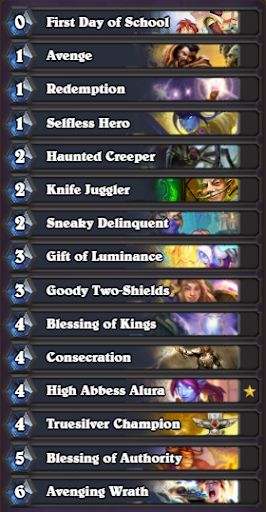
Unfortunately, Paladins are still stuck with their resurrection hero power if they want to achieve anything of note in Duels. Getting bigger Silver Hand Recruits somewhere beyond turn six isn't much help in a format built around crazy combos, while Warriors are infinitely better at pulling off Menagerie strategies.
It may seem a good idea to go for maximum greed with the Paladin’s hero power, playing premium minions so you can reliably resurrect them, but the meta is too fast for that approach. Instead, wielders of the Light are forced to study the dark arts of aggression to survive early encounters. You win those initial fights by sticking a cheap minion on the board so that you can target them with an on-curve Blessing of Kings or Blessing of Authority. The return of Selfless Hero further enhances this strategy. The trick is to sacrifice late-game bombs in your starter deck and pick them up later on if the correct treasures present themselves, leaving you with something like this:
Deck code:
AAEBAZ8FD57NA4wOjAHUrgL1DbEIitQDp8sDytEDrwfcA8PRA88Gv9EDlgkAAA==
Cost: 2700
Hero Power: From Golden Light
Signature Treasure: Royal Greatsword
Best passive treasure: The new Sandy Surprise guarantees that your buff targets stick on the board, making it safer to play out even against ping classes. Rocket Backpacks augment your buff strategies well, especially if you pick up Lightforged Blessing for big comeback plays. Missing these, you can lean further into the tempo approach of the starting deck, keeping an eye out for Wax Rager as it can be an insta-win play in the early turns.
Warlock
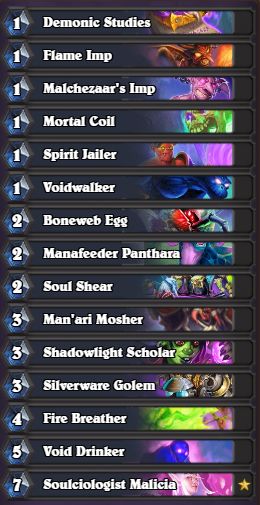
Warlocks’ Discard synergies received a bunch of serious buffs, but it’s the cheap Demon package from Madness at the Darkmoon Faire that made them so competitive. Man’ari Mosher and Fire Breather add some much-needed stabilization tools to the archetype, which now has a monstrous payoff in the form of Killmox, the Banished One. The trick here is to avoid cutesy plays. Apply pressure early on and never let up. Cheat free minions onto the board with your Discard synergies and use the signature treasure as the coup de grace instead of your only big threat, as it will inevitably get removed after it rushes onto the board.
Deck code:
AAEBAf0GD87SA8IIvLYCzgfM0gMw1dEDzdID3Ab/zgPUswKODvoOuM4Dz9IDAAA=
Cost: 2600
Hero Power: Dark Arts
Signature Treasure: Killmox, the Banished
Best passive treasure: To ensure that you get the most mileage out of Malchezaar’s Imp, Sandy Surprise should be your first choice. It’s tough to highlight a specific synergy from pool 2, meaning Emerald Goggles is perhaps your best bet.
One more thing. Though you nearly always want to pick the empty buckets to maximize the consistency of your deck, a build focusing on Discard synergies will always want the biggest deck possible. Then they can discard to their hearts’ content without risking an automatic loss to fatigue in slower matchups.
Hunter
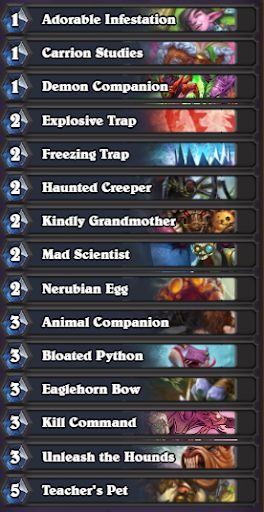
Hunters are so good Blizzard had to remove a pool 1 treasure to compensate for their newfound power. Deathrattle-based builds with a synergistic Hero Power are predictably powerful, and they are now the deck to beat in the format. Go too slow at your own peril: Endless Eggs and resummons will run even the greediest decks out of board clears in no time.
The class’ other options don’t hold a candle to Death Games: you can pump out over-statted minions as early as turn two, while many decks don’t even get the chance to execute their strategy before you destroy them. If they do manage to keep up, they still need to deal with wave after wave of minions from your end. Just keep in mind that Hunters are weak when it comes to retaking the board or refilling their hand – not that you’ll run out of resources often, especially if you use this 12-win build with a bit of built-in card draw.
Deck code:
AAEBAR8PudIDnssDuK0Clwi5tAL7AfoNtM4D/gyoAtsJj+MDks0DuuED+uEDAAA=
Cost: 2680
Hero Power: Death Games
Signature Treasure: Bonecrusher
Best passive treasure: Cannibalism is the premium pick from pool one and either Totem of the Dead or Mummy Magic should ensure a high-win run if you find it in pool two.
Priest
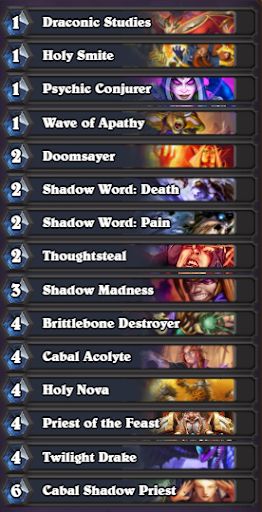
Like every good Priest deck, a good build in Duels prevents its opponent from using minions by taking said minions for itself. This doesn’t necessarily make for a reliable strategy deep into your run, while your treasures will have to bail you out when it comes to mana cheating or resource generation.
Not much has changed in that sense with the launch of the new expansion, as a control build still remains the best strategy for the class. However, Droplet of Insanity is a much better option for your starting treasure, allowing you to generate additional card advantage in the longer battles.
Deck code:
AAEBAa0GDx6KAdwBkAKXAskGjQjTCtcKkrQC3swDy80D1s4D49EDotUDAAA=
Cost: 1620
Hero Power: Shadow Mend
Signature Treasure: Droplet of Insanity
Best passive treasure: Cheaper spells with Rhonin’s Scrying Orb should be your main priority from pool one. Follow this with Battle Totem in pool two, which can be incredible in the right Priest build, offering near-endless card-generation guaranteeing wins so long as you can keep yourself alive.
Druid
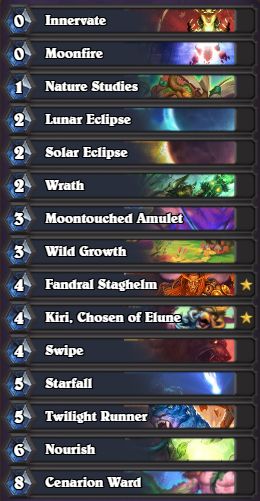
Druids were railroaded into the Guardian Animals approach, until the arrival of the new set, but the Eclipse synergies now clearly, well, eclipsed that archetype. The class is still quite difficult to play, but while it remains a one-trick pony, the trick is a lot better this time around.
Deck code:
AAEBAZICD0BWX/4B0wPEBuQIrqsCm84D3tEDieADiuADouEDpOEDpeEDAAA=
Cost: 4160
Hero Power: Nature’s Gifts
Signature Treasure: Moonbeast
Best passive treasure: Robe of the Apprentice and Rhonin’s Scrying Orb are the best ones to start with, and with some luck, you can find Double Time from pool 2 to get the strongest possible Druid run.
The best active treasures
Not all the treasures in Duels are passive effects; many are individual playable minions and spells. Though your class and deck will have a large impact on the correct choice, some of them are a cut above the others and should always warrant consideration. They don’t always appear at the same time, either. Your first treasure offerings are from 'pool one' which are considerably weaker than the showstoppers from “pool two”.
Hyperblaster is a brutally effective removal tool for every class that doesn’t rely on weapons to deal face damage. Surly Mob, Wand of Disintegration and Staff of Scales fulfill a similar role. Wax Rager (and to a lesser extent, Grimmer Patron) can insta-win you the game if you rely on early wide boards. In the late game, Dreamgrove Ring offers a similar sort of threat. Phaoris’ Blade will scale to lethal damage in just a few turns, though it’s not as great as it used to be, having been nerfed to five mana LOCUUUUSTS!!! and Pure Cold can augment any burn-based strategy. They are all great cards, but only your decision-making can get you all the way to twelve wins.

